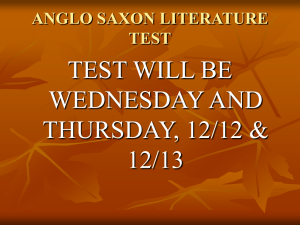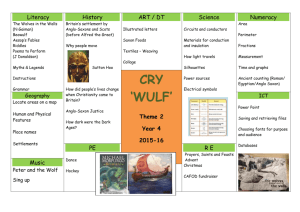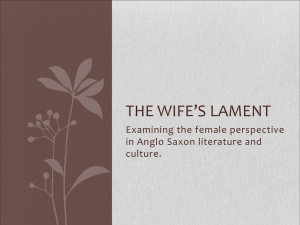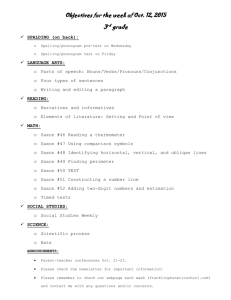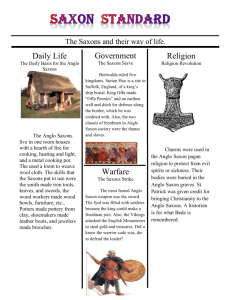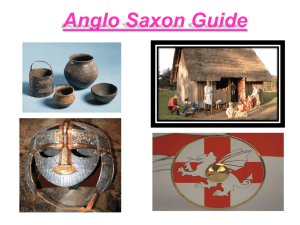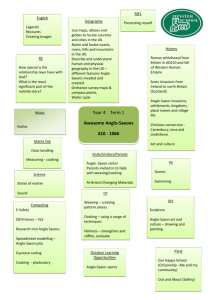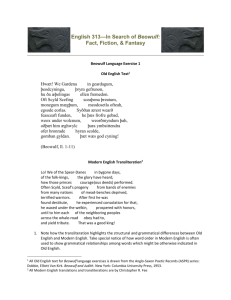Teachers - casetv.com
advertisement
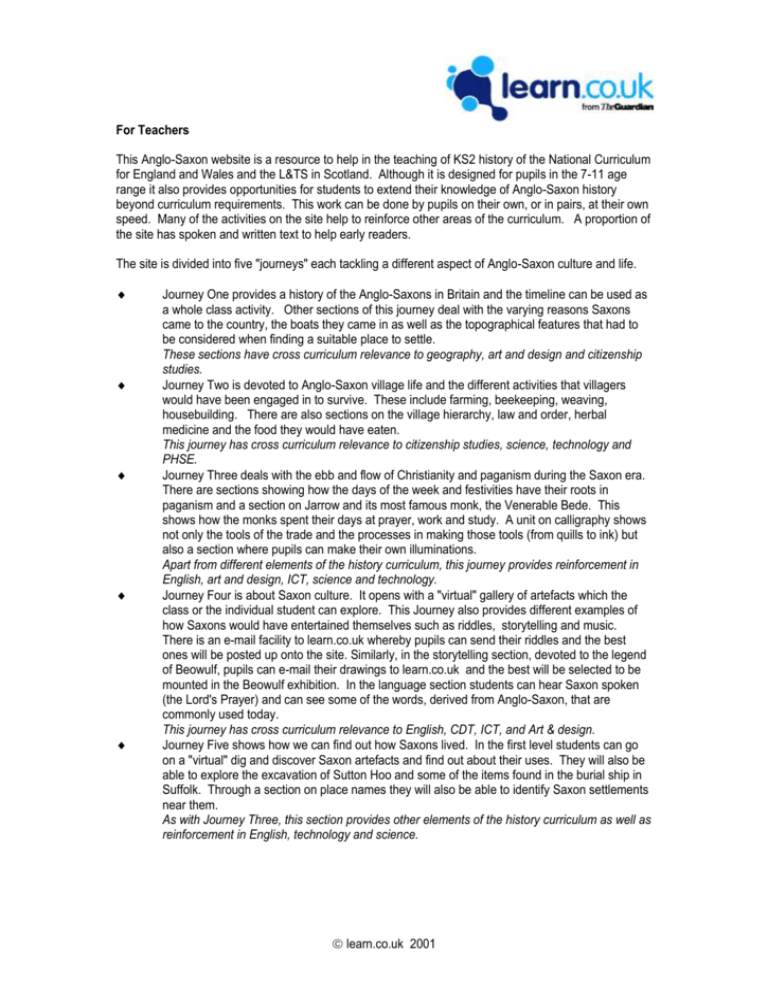
For Teachers This Anglo-Saxon website is a resource to help in the teaching of KS2 history of the National Curriculum for England and Wales and the L&TS in Scotland. Although it is designed for pupils in the 7-11 age range it also provides opportunities for students to extend their knowledge of Anglo-Saxon history beyond curriculum requirements. This work can be done by pupils on their own, or in pairs, at their own speed. Many of the activities on the site help to reinforce other areas of the curriculum. A proportion of the site has spoken and written text to help early readers. The site is divided into five "journeys" each tackling a different aspect of Anglo-Saxon culture and life. Journey One provides a history of the Anglo-Saxons in Britain and the timeline can be used as a whole class activity. Other sections of this journey deal with the varying reasons Saxons came to the country, the boats they came in as well as the topographical features that had to be considered when finding a suitable place to settle. These sections have cross curriculum relevance to geography, art and design and citizenship studies. Journey Two is devoted to Anglo-Saxon village life and the different activities that villagers would have been engaged in to survive. These include farming, beekeeping, weaving, housebuilding. There are also sections on the village hierarchy, law and order, herbal medicine and the food they would have eaten. This journey has cross curriculum relevance to citizenship studies, science, technology and PHSE. Journey Three deals with the ebb and flow of Christianity and paganism during the Saxon era. There are sections showing how the days of the week and festivities have their roots in paganism and a section on Jarrow and its most famous monk, the Venerable Bede. This shows how the monks spent their days at prayer, work and study. A unit on calligraphy shows not only the tools of the trade and the processes in making those tools (from quills to ink) but also a section where pupils can make their own illuminations. Apart from different elements of the history curriculum, this journey provides reinforcement in English, art and design, ICT, science and technology. Journey Four is about Saxon culture. It opens with a "virtual" gallery of artefacts which the class or the individual student can explore. This Journey also provides different examples of how Saxons would have entertained themselves such as riddles, storytelling and music. There is an e-mail facility to learn.co.uk whereby pupils can send their riddles and the best ones will be posted up onto the site. Similarly, in the storytelling section, devoted to the legend of Beowulf, pupils can e-mail their drawings to learn.co.uk and the best will be selected to be mounted in the Beowulf exhibition. In the language section students can hear Saxon spoken (the Lord's Prayer) and can see some of the words, derived from Anglo-Saxon, that are commonly used today. This journey has cross curriculum relevance to English, CDT, ICT, and Art & design. Journey Five shows how we can find out how Saxons lived. In the first level students can go on a "virtual" dig and discover Saxon artefacts and find out about their uses. They will also be able to explore the excavation of Sutton Hoo and some of the items found in the burial ship in Suffolk. Through a section on place names they will also be able to identify Saxon settlements near them. As with Journey Three, this section provides other elements of the history curriculum as well as reinforcement in English, technology and science. learn.co.uk 2001 Some tips on the use of the site: 1. Navigation There is usually a choice of ways to navigate the site. For whole class use, the menu bar, tucked away at the top right hand corner of the screen, can be dropped down and dragged anywhere you want on screen. This will take you instantly to other parts of a journey, or to the Home Page from where you can navigate to another journey. For younger children, we also have onscreen back buttons and other navigational tools that are clearly signposted. 2. Most text is confined to text boxes in the bottom right hand corner of the screen. Sometimes, where further explanation is needed, we use rollovers which are clearly highlighted. These devices have been used to avoid large quantities of text on a page in one go. 3. All instructions are in red and located in the bottom right hand corner of the screen. It might help to mention this to pupils if they are about to use the site for the first time on their own. 4. Sound button To help students whose reading levels are less advanced we have duplicated much of the copy in sound. This can be controlled by sound “On” and “Off” buttons on the drop down menu bar. If your class is working on the site at different computers it might save pupil confusion (and your sanity) if you instruct them to click on the sound “Off” button. 5. Printing To limit your printing ink bill we have reserved the print facility for only a few items on the site. These are usually task sections such as “Make a brooch” or the “Illumination” section. However, for the teacher’s benefit, we have provided some copy below which is either a replica of the copy on the site or a resume of a section. Sometimes we have provided footnotes where there are differences in historical opinion. 6. In the following content, text in blue is copy that appears on the website. Key content Journey 1 Timeline By clicking on a century at the top a potted history of that century is provided in the text box. Information is sometimes augmented by rollovers. In centuries where there are several major events, a second timeline appears at the bottom. By clicking individual decades or years a resume of events appears in the text box. Intro The Anglo-Saxons were made up of many tribes from north-west Europe. The tribes who populated the British Isles were mostly the Angles and Saxons from north Germany and the Jutes from Denmark. learn.co.uk 2001 It isn't known exactly when the first Saxons landed, but it was most likely in the 5th Century when the Romans had pulled out of Britain. The following section plots Anglo-Saxon history in the British Isles. Use the timeline to navigate the map on the next page. 200-299AD: It is known that Saxons were attacking the coast of Gaul, in what is now France, by the end of this century. There is little evidence to support the theory that they had landed in the British Isles by then. 300-399AD: Coastal fortifications were built by the Romans during this century. Up until now it was thought these were to keep the Saxons out, hence the name Saxon Shore. However, experts now suspect these were built by rebel Romans to keep out fellow Romans. 400-499AD: The Roman legions were withdrawn from Britain around 410AD and the Britons were left to defend themselves. They hired some Saxons to help. But around 450AD these Saxons rebelled and took over southern England as far as the West Country. 500-599AD: Many small Saxon kingdoms emerged in this century. In 577 the Saxons won the "Chesters", Gloucester, Cirencester and Bath, cutting links between Britons in Wales and West Country. 597: Christianity once again began to spread through England. 600-699AD: During this century the many small kingdoms merged to become seven large ones. 625: The Sutton Hoo burial. 635: Lindisfarne monastery founded. 663: Synod of Whitby is held. 673/81: Monasteries at Wearmouth and Jarrow founded. 700-799AD: Before his death in 735 the Venerable Bede, living at Wearmouth-Jarrow, recorded a diary of historical events in the country. 757-796: King Offa of Mercia became the first king of the English. 800-899AD: The Vikings invaded and settled. 850: The Vikings, from Denmark and Norway, made their first permanent settlements in England. They remained after plundering cities like London and Canterbury. 867: The Viking kingdom of York was established as the Vikings conquered the Kingdoms of East Anglia, Northumbria and Mercia. They then began to move into Wessex. 871: King Alfred fought the Vikings but was defeated. The Vikings then marched north to quell rebels in Northumbria. 878: The Saxon king, Alfred, led his army to victory against the Vikings at the historic battle of Edington in Wessex. King Alfred showed mercy to King Guthrum and his men who then agreed to convert to Christianity. The Vikings were moved to an area called "The Danelaw". 890: The Anglo-Saxon Chronicle was begun on the orders of King Alfred. This told the story of what happened to the Anglo-Saxon people in England from 400AD. It was continued after Alfred's death until the end of the Saxon era in 1066. The peace with the Vikings was broken and land and sea raids began again. 899: King Alfred died and his son Edward became king. Fighting between the Saxons and Vikings continued. 900-999AD: 900-937: Gradually the Saxons regained the land that made up the Danelaw. 959-975: Government under Edgar, Alfred's grandson, and Dunstan led to the "Golden Age" of Saxon England. learn.co.uk 2001 1000-1100AD: The final Saxon century before being conquered by the Normans was a troubled one. There were many raids by the Vikings from Norway and Denmark. Click the dates on the timeline to the left to find out more. 1000 -1016AD: Ethelred the Unready, a foolish and treacherous king, treated the Vikings badly and massacred them. This led to savage raids on the Saxons by the Vikings. 1016: The whole of England was conquered by the Vikings or Danes, and the Danish king Canute ruled. 1042: One of King Canute's sons had taken over as king but died leaving no heirs, so a Saxon, Edward the Confessor, became king. 1066: In September the Vikings from Norway landed and Harold led the English army to fight them at Stamford Bridge near York where the English won a great victory. Harold then learnt of the landing of the Normans on the south coast and rushed to fight them. On 14th October 1066, Harold died at the Battle of Hastings and the Normans began their conquest of England. A full report of the battle was recorded using a 73m long piece of cloth with embroidered pictures. It is called the Bayeux Tapestry. The Saxon era was over. Saxon life still continued but under strict Norman rule. Edward the Confessor died in January 1066, and Harold of Wessex was elected king. But William of Normandy and Harald Hardrada of Norway both claimed a right to the crown. England was to be invaded by two separate armies and Saxon rule was to come to a bloody end. 1100AD: The rule of the Saxons ended with the Norman conquest of England and a new chapter in English history began. Saxon rule was over, but the influence of the Saxon people and their culture has remained with us ever since. Why they came Three different Saxons explain in an audio visual section why they came to Britain. There’s a soldier who came as a mercenary, a farmer’s wife who came to find better land, and a trader. Trader “I've been across the sea with the Britons and Romans many times. Now, Britons make good cloth from wool and their tin, well their tin is certainly the best I've ever seen. They like to buy our weapons. The Romans have fine pottery and they like the jewellery and glassware and skins that I bring in. Now, some of the Romans have plenty of land and wealth and they've grown fat on it. Now, I might stay over there soon because I'm doing good business. But the Romans, well the Romans are wary of us and want to keep us out. Some say that they will weaken soon and then we will be able to come and settle. My trade will be good then.” Soldier “I have been in many battles. Oh yes, yes. And my spear needs sharpening. Our land here is always being challenged by other tribes, it's a hard life, but I enjoy it, beating off the others. Do you know, I know some soldiers, I actually know some soldiers that have gone to Britannia to work for the Romans. I think they are called mercenaries. But I tell you they won't keep us out. Do you know, actually, I've been to Britannia on a raid. Oh yes, yes, years ago. We managed to grab some cattle, a few slaves, some weapons, and some treasure from a little Roman Villa that we kicked to pieces. Yes, yes. But it's still not enough. Soon we will be able to settle there and my job will be to conquer other tribes and protect new villages.” learn.co.uk 2001 Farmer’s wife “It's hard growing enough food for our village. The weather's always cold and there's just not enough good land left around here where we live. But I have heard about the fine land that's in Britannia, easy to plough and the summers are longer too. And they say that the Romans have left their shore forts and with the coast undefended it'll be much easier to go there and settle. There's talk of our whole village moving to this new land. We'll take our animals and everything with us and start a new life. They say that we might have to clear some forests to make land for farming but it will be much easier than here.” How they came The Saxons came in “keels”. This section compares different marine vessels from different periods and invites the student to work out which one is the Saxon keel. When the student has selected the correct vessel, they can then go on to build the “keel”. This section could be used for Design and technology. A point of information. The Saxon keel we show has no sail, which is in keeping with earlier Saxon vessels. Later ones, like at Sutton Hoo, probably did have sails and looked a little more like Viking longboats. What soldiers wore A drag and drop game for pupils to dress different soldiers who would have been joined in battle in the British Isles during the early Saxon period. This section could be used for Art and design as well as Saxon history. Find a village site A fun task for pupils. They have to look at the topographical map and decide where to build a Saxon village. At the beginning of the game they are prompted to look for certain features on the map. Those who think rather than just click are rewarded with a higher score. There’s a key for them to identify topographical features. This section can be used for Geography as well as History. Journey 2 Rotation farming We show the rotational farming plan where crops and livestock dovetail with each other to ensure healthy growth of crops. Explanations of why it works are provided in the on screen text box. A key historical point here is that the Saxons borrowed the rotational strip farm system from the Romans. It wasn’t invented by the Saxons. This section can also be used for Science. Law and order A resume of how guilt and innocence was determined, examples of King Alfred’s laws and the punishments inflicted under the Saxon judicial system. Many words related to the law, and the jury system, are still with us today. This section could be used for Citizenship studies Food Very little food could be stored, so Saxons ate what was available seasonally. This gives a very brief glimpse of some of the foods Saxons might have eaten. This section could be used for Science in comparing food preservation today and in Saxon times. learn.co.uk 2001 Weaving and dyeing A detailed description of the different processes involved in weaving and dyeing. This section can be used for Art and design and Design and technology. The wool was sheared from the sheep. Iron shears were used which had to be sharpened frequently. The wool was spun using a drop spindle. As the spindle turned, the wool fibres were twisted into yarn then wound round the spindle. The spinner made a short length of yarn by twirling the fibres by hand. When it was long enough it was tied to the spindle. The yarn was held in place at the top by a small groove and the fibres fed through as the spindle spun. The forked stick was called a distaff and was used to keep the lengths from tangling. The yarn would next be coloured using dyes made from natural sources like berries, plants and even shellfish. Woad leaf - made blue dye. Weld plants - made yellow dye Madder root - made red dye. Yarn was woven on a loom. The up and down threads (warp threads) were weighted at the bottom to keep them taut. The yarn was then woven between the warp threads using a shuttle. Different weaving patterns like "herringbone" and "twill" could be produced by varying the number of warp threads that the weft would miss out or clump together as it passed back and forth. The shuttle wove in and out of the warp threads or group of threads depending on the style of weave wanted. Weights held the warp threads firm. The bar going across was called the heddle rod and pushed the weft down tight. Who’s who? The social structure of Saxon village society, from the bottom up: serf, ceorl, thegn, eorl and king. They each had their value and their role to play as we show in the click through section. Serf The richest serf might be worth around 50 shillings (or £50,000 today) but most owned nothing. ”Oh life is hard! I work all day and I own nothing. Everyone has power over me and I have to put up with what they say, but that's life!” Ceorl Worth around 200 shillings (over £200,000 today). This is what he says: “Well, I'm a ceorl and that makes me middle class. But it doesn't feel like it! I own some land but not a lot. I obey my thegn but if my farm does really well and I fight bravely in the fyrd... then just maybe I might, one day, be made a thegn. Then I'll have real power and not just over the common serfs!” Thegn Some thegns could be worth up to 1000 shillings (£1,000,000 in today's money). This is what he says: “Some of us thegns are almost as powerful as the eorls but I am not... yet! I have power over the ceorls and make sure that the laws are carried out and that the villagers prosper. Perhaps the king will notice my good work and make me a SPECIAL thegn or even an eorl! One can hope.” learn.co.uk 2001 Eorl An eorl would have been worth at least 1000 shillings, (£1,000,000 in today's money). This is what he says: “An eorl am I and pretty important too! I advise my king and own more land than a serf can imagine! I also have power over some of the lesser thegns, which probably aggravates them as I know they want to be like me!” King Worth a king's ransom which was hard to put a price on. He was worth more than everyone put together. This is what he says: “Well, subjects! I'm king and what an important person I am. I am lord of all I survey including all of you! My orders must be obeyed and you never know when I might need some soldiers for my fyrd!” Herbal medicine A drag and drop game where pupils have to match the ailment with the medicinal herb to cure Egbert. This section helps reinforce the names of parts of the body so can be used in Science. Build a Saxon house A drag and drop facility where the pupil can build a Saxon house. Beekeeping The processes involved in keeping bees, and collecting/preparing the honey and wax. The Saxon hive was a conical-shaped basket called a skep. To make the skep, long straw was used and stitched together using blackberry briar. A typical hive, or skep, held six to eight honeycombs, attached at the top and sides. The conical "hat" was called a hackle. The hackle would be placed on the skep to protect it from wind and rain. When the beekeeper wanted to get the honey he would use smoke to make the bees drowsy so he didn't get stung. Some of the honeycomb was taken from the beehive and the honey extracted by squeezing it through a cloth bag. Raw honey was mixed with a little water and heated for half an hour to remove impurities. Honey had many uses. It sweetened food, made a drink called mead and was an important ingredient in making ink. Mead was a sweet alcoholic drink enjoyed at festivals. Beeswax was used for candles, writing tablets and also in the making of bronze and metal jewellery. The Saxons would scratch words into wax and then erase their mistakes by melting the wax. The method for casting was called "lost wax". The object was first modelled in wax and a clay mould was made of it with a hole in the top. Molten metal was poured in. The wax would melt and the metal would take the shape of the wax object. To make a candle the wick was dipped into molten wax allowing it to cool each time. This was done until it was thick enough to be used. learn.co.uk 2001 Journey 3 Spread of Christianity When the Saxons arrived on British shores, the population was already Christian. The Saxons brought paganism, then converted to Christianity until the Vikings re-introduced paganism. The Vikings eventually converted to Christianity at the insistence of the Saxon king, Alfred. This section maps the ebb and flow of Christianity/Paganism during the 600 year long Saxon reign. When the Saxons settled in England the country was Christian. The Saxons brought with them paganism, a religion which worshipped many gods. The following pages show the ebb and flow of Christianity and paganism in Saxon times and the part both religions have played in our cultural heritage. 400-499AD: Christianity became the official religion of the Roman Empire in 310AD, so when the Saxons first arrived in England, the population was Christian. 500-549AD: The invading Saxons brought with them their belief in pagan gods. 550-599AD: Paganism spread across England with the Saxons. At just this time Christian monks landed in the north and south of the country. - 563: St Columba arrived from Ireland and set up a monastery on the remote island of Iona, off Scotland. 597: St Augustine arrived in Canterbury, on a mission from the Pope in Rome to convert the Anglo-Saxons to Christianity. 600-649AD: Saxons converted to Christianity and paganism survived only in the centre of England. In 635 a monk from Iona called Aidan founded the monastery at Lindisfarne. - 635: St Aidan left the monastery to set up a new one at Lindisfarne, a small island off the coast of Northumbria. It became famous for the illuminated manuscript called the "The Lindisfarne Gospels". 650-699AD: By now most Saxons were Christian. In 673 Bede was born. He wrote the history of the Saxon conversion to Christianity. Bede lived in the twin monasteries of Jarrow and Wearmouth. - In 682 the monastery of Jarrow was founded. It became a centre of learning for the AngloSaxons. 700-799AD: The Vikings invaded England and brought with them the old pagan gods. The monasteries were repeatedly attacked and "sacked" or destroyed by the Vikings. 800-899AD: The Vikings continued to destroy Christian centres as they settled as far north as Scotland. Jarrow began to decline as a centre of Saxon culture. In 887 Alfred of Wessex began to convert the Vikings to Christianity. 900-1000AD: Alfred continued his conversion of the Vikings until 910, returning Britain to the religion it had followed over 500 years before. The pagan festivals were slowly absorbed into Christian ones. Pagans A drag and drop game illustrates the days of the week, and how most days of the week (except Saturday) owe their origin to pagan gods. Another section shows how Christian and pagan calendars merged. learn.co.uk 2001 Calligraphy A grumpy monk encourages students to find out about the tools required for calligraphy and how they are made, by clicking on items on his desk. We introduce students to the following: how parchment is made (by skinning farm animals, drying the skin and scraping it to a fine vellum). how a quill is made (swan’s feather with plume part removed and shaping the end to form a nib. How ink is made (honey, soot and egg white mixed together). How candles are made (string which is dipped several times in liquid wax). Illuminations. We show three examples from famous manuscripts of illuminated letters. These include the Lindisfarne Gospels, the Book of Durrow and the Book of Kells. A short history of each document is provided. Pupils can then have a go at illuminating the first letter of a message they type in. They will be able to print this out for classroom display. This whole calligraphy section can be used for a variety of KS2 studies: Art and design; Design and technology; Science; English. Bede A question and answer section on the Venerable Bede who lived his life as a monk between the twin monasteries of Jarrow and Wearmouth. The full text of what he says is reproduced below. The Venerable Bede was born in 673AD and lived most of his life at Jarrow or its twin monastery at Wearmouth. It was here he wrote his most famous work: "The History of the English Church and People" which chronicled the spread of Christianity amongst the Saxons. To do this, Bede gathered as much information as possible from those who saw the events he described. Now you can gather information from him as he talks about his life. When did you decide to become a monk? My parents gave me to a monastery when I was seven years old. I didn't go to the new monastery at Jarrow until I was 12. That's where I spent the rest of my life. When I arrived, the monastery was still being built, but I was quite old before it was finished. What were you taught as a child at the monastery? I was taught how to read and write using a wax tablet, as it was too expensive for us to practice on vellum. We also learned how to make a quill from a swan's feather. When I had proved that I could write well I was allowed to work in the scriptorium, a sort of large study. We created beautiful books, decorated with fine illuminated letters. These books were made of vellum pages and some had over 500 calf skins in them. Sometimes, sometimes they weighed as much as a 12-year-old boy! It could take a monk over a year to finish a book! It was long and sometimes very cold work, especially in the winter. What was life like in the monastery? Life was hard, and for some it could be short at the monastery. Many of the monks during my lifetime died from the plague. When did you have to wake up for prayers? Every day I would attend many masses in the chapel. The first mass would begin at 2 o'clock in the morning! All work and writing would stop when the bell rang for mass. How old were you when you become a priest? learn.co.uk 2001 I became a priest at the age of 30. Whilst I was at Jarrow, the monastery had become a well-respected place for learning and scholarship. What did you do apart from praying and writing? When I was young I would help to harvest the honey and beeswax from the hives. We used the honey for eating and making ink for writing. It was my job to help milk the cows and work the fields. Sometimes I would help prepare the skins for making vellum. What did you do when you grew up? I loved writing and most of my work was based on a study of the scriptures, or translating from Latin into English. I also wrote on other subjects as I was encouraged to study for my own use as well as for my fellow monks. I thought it was important to write a history of the English people. I very seldom travelled from Jarrow so it made it hard work to write about the whole country, as I wanted to write the truth. But different people will tell you different stories about the same event! I had to find as many accounts as I could, and make up my mind which story was the correct one. It took me many years to complete it, but I think I got most things right in the end. When did you die? I died in the year of our lord 735, and I had finished many books, all written by hand. Some say that a lot of what you can find out about the Saxons is based on my writings. That would please me very much if it is true. Pax vobiscum. Go in peace. Journey 4 Artefacts This “virtual” art gallery shows works of Saxon artisanry, with explanations of the materials required, the processes involved in the making, and what the item would be used for. Sections include: ironwork, pottery, jewellery, bone work, braid, wood work, sculpture and glass. Entertainment What Saxons would have done in their down time. An introduction to storytelling – Beowulf, riddles and music. The Story of Beowulf The story is presented audio-visually and a text of the spoken words is also provided. This graphic story is illustrated with pictures produced by primary school pupils. There is an e-mail facility in this section for students to attach a scanned-in painting and e-mail it to learn.co.uk. Some will be selected for display on the “virtual” gallery walls. Opportunities for cross curriculum studies in English and Art and design. The story Part 1 In a land Denmark across the cold waters of the sea lived a great king named Hrothgar. He was a very successful king who gave gifts and riches to his subjects. He built the most amazing and grandest hall on Middle Earth. He named the hall "Heorot" and it was the longest, highest and most greatly decorated hall ever to exist. There would be feasting in it every night. There would be many stories told of bravery, learn.co.uk 2001 cunning and superhuman warriors. After the feasting the mightiest warriors of the town would sleep in the hall. One feasting night there was more rejoicing than usual. Poets had been paid to tell stories of Hrothgar's feats and the laughter and cheers filled the air. But outside there was a terrible something lurking in the dark. Its name was Grendel. He was hideous, huge, slimy skinned, and had eyes that pierced the night gloom. This strange man-monster hated the laughter and rejoicing. When all had gone quiet and the warriors were sleeping, the monster pulled open the great doors to the hall and killed 30 warriors in their sleep. The people awoke and wailed at the loss of so many men. The king vowed that there would be no more feasting after dark in the Heorot in case the monster would return. The next night the monster did come back but no one was in the hall and it returned to the moors empty handed. Not one warrior volunteered to go after the monster. The ban on after dark feasting in Heorot carried on for 12 long years and the hall became empty and silent every nightfall. The king became old and helpless. Part 2 In a land called Geatland that lay across the cold treacherous sea a young warrior had heard of the terrible monster. He told his warrior friends that he would go and prove himself against this demon. His friends vowed that they would accompany him in this terrible quest. So 14 warriors and Beowulf set off across the sea in their fine ship.They landed on the shore of Denmark and set off through the moors towards the old town where the great hall Heorot stood. When they arrived they were greeted by the old king. When Beowulf told him what he had come to do the king ordered that the first feast for twelve years would be held in the hall. It was a grand feast held in Beowulf's honour and was full of brave stories, good food and drink. As the night drew on the Danes went back to sleep in their houses but Beowulf's warriors and he decided to sleep in the hall. A dense heavy sleep descended on the warriors as something stirred across the moors. Grendel had heard the sounds of enjoyment and had come to revisit the hall. He ripped open the great doors and grabbed the nearest warrior. He cut his throat with one claw and then ripped him to pieces and ate him up completely. Next he reached for the second warrior, Beowulf! But Beowulf was awake and grabbed the monster's arm. The monster tried to get loose but Beowulf held on. The other warriors were awake now and slashed at the monster with their swords. But his skin was too tough! Beowulf twisted the monster’s arm behind his back and twisted some more and twisted some more. The monster lurched away with a great heave then he ran from the room… leaving his arm in Beowulf's hands. The arm was huge and each claw was as long as a dagger. Beowulf was congratulated, cheered and thanked by the Danes. The arm was nailed to the wall outside the hall where all looked and gasped at its appearance. A great feast, even greater than the night before, was held in the hall that night and the king told Beowulf that he was to sleep in his home. As the feast came to an end, Beowulf's warriors settled down to sleep. Again a deep, heavy sleep descended on them as something slid through the mists of the moors. Part 3 learn.co.uk 2001 This "something" had fury, sorrow and revenge in its blood. It was Grendel's mother. She had come to avenge her son. She too was a hideous being with a fearful stare and an appearance that would chill a man's soul. She crept up to the hall, opened the doors scooped up and dragged the first warrior off into the night. The other warriors awoke and saw that one of their friends had gone. Beowulf rushed into the hall and declared that he will hunt down and kill this demon mother. Beowulf and his warriors started out in their quest following the tracks left in the soggy soil on the moors. They travelled across strange windswept land and a strange frozen totally still forest. Eventually they came to a steep grey cliff that dropped down to a lake, but this lake looked like no other. Its water was stained with blood. It steamed and bubbled, blue flames spat out of the liquid and demons swam on the surface. Down underneath the surface lay the monster’s lair. Beowulf told the warriors that he would climb down to fight Grendel's mother. Unferth, a close friend of Beowulf, offered Beowulf his own sword "Hrunting". "This will protect you in all adversity!" Beowulf took the sword, greeted all the warriors and dived into the foaming liquid. As Beowulf dived down, Grendel's mother swept up to meet him. She grabbed Beowulf and dragged him into her cave under the water. Part 4 The battle commenced. Beowulf broke free of her grasp and slashed his sword at the monster's head. Although she wailed, the sword had done her no harm. Beowulf threw the ineffective sword away as he thought it was no match for the monster’s magic. As Beowulf looked behind him Grendel's mother tripped him and stabbed her dagger at his heart again and again. Beowulf was not harmed! His strong chainmail had protected him. He saw a huge, magnificent sword with a gold hilt leaning against the cave wall and he grabbed for it. He slashed out and it slashed through the monster's throat and smashed through her spine. She dropped dead on the spot. As he explored the cave he found the dead body of Grendel who had bled to death from the open wound where his arm used to be. Beowulf cut off his head as a souvenir and was about to take the sword as well. But as he held it the poison in Grendel's blood began to melt the sword so Beowulf decided it was time to leave and rejoin his friends. He took the head and the golden hilt of the now bladeless sword and climbed up through the swirling blood-tainted water. His warrior friends had been very anxious as they waited for nine hours and were really relieved as they saw Beowulf climb towards them. At the top of the cliff Beowulf stuck Grendel's head on a pole and led their return to Heorot. They set off for the strange lands rejoicing as they travelled. As they drew in sight of Heorot all of the Danes could see the head and began to chant "Beowulf!" "Beowulf!" "Grendel is dead!" "Grendel's mother is dead!" learn.co.uk 2001 Beowulf gave back Hrunting to Unferth and told him it was a good sword but no match for such an enemy with magic powers like Grendel's mother. He also gave the golden hilt, that came from the wonderful sword he found in the cave, to the old king, Hrothgar . There was the finest most wonderful feast held in Beowulf's honour that lasted long into the night. The next morning it was time for the warriors to leave and set off for their homeland across the sea. The king presented Beowulf some fine gifts in gratitude: four fantastic brown horses; a flag with a boar’s head design; a very special helmet; and a new coat of chainmail. Soon the brave group were in their ship slipping through the chill water, sailing towards their homeland the green Geatland. THE END Riddles A “Guess the Riddle” game. These are genuine – if simplified – Saxon riddles. They are not easy to decipher, so we’ve provided clues. There is also an e-mail facility whereby pupils can send their own riddles to learn.co.uk and some will be selected to go on a riddles page. Music Examples of Saxon instruments, how they are made and what they sound like. Language Three sections: Dictionary. This shows short lists of words in use today that derive from Saxon. Runic alphabet. Not only is there the runic alphabet, pupils can write a secret message in runes to their friend. The Lord’s Prayer, spoken in Saxon, to give pupils a flavour of what the language might have sounded like. All these sections provide scope for cross curriculum English studies. Make a brooch A fun design game where four different basic shapes – round, square, rectangular, trianglar -- can be transformed into beautiful Saxon brooches by dragging and dropping a selection of patterns, textures and colours on a “palette”. This can be printed out for display purposes. (There’s no evidence the Saxons used triangles as a shape and square brooches have been found, but rarely. Most brooches are circular.) This section has both cross curriculum use in Maths and Art and design. Journey 5 Archaeology Our friendly - if tetchy - skeleton introduces us to what archaeology is all about and invites the pupil to go on a “virtual” dig. The site the pupil clicks through to echoes the village from Journey 2. An archaeologist guides them through the excavation and by clicking on pegs on the site they discover items which they have to identify. There is also information about the items and what clues they give us to the way Saxons lived. This section addresses the National Curriculum requirement to identify ways we find out about the past. Sutton Hoo An interactive guide to the Sutton Hoo dig with images and details of some of the many items found. learn.co.uk 2001 - - - - - Sutton Hoo, excavated in 1938-9, is the famous Anglo-Saxon pagan burial ship that dated from the 7th century. In its numerous mounds, on the East Anglian coast, were found some of the most beautiful Saxon artefacts ever discovered. The Sutton Hoo site was owned by Mrs Pretty, an amateur archaeologist. She was keen to find out more about the contents of the mounds and engaged Basil Brown to excavate the site. Burial ships were a pagan tradition. The scale of Sutton Hoo though means it could only have been for a high ranking citizen, almost certainly a king. There is no conclusive evidence a body is buried at Sutton Hoo and expert opinion differs on this. Times were turbulent when Sutton Hoo was constructed. It's possible a body was buried with it as a pagan and dug up by Christians for Christian burial. We simply don't know. Nor do we know who Sutton Hoo honoured. The dates on the coins suggest King Raedwald who reigned in the area at the time, but that's speculation. Basil Brown, an archaeologist, was given the task of excavating the site by its owner Mrs Pretty. Mound 1: It was a full year before Brown felt confident enough to tackle the large Mound 1. In it was discovered the most remarkable remains of a burial ship with many of the fine possessions buried within it intact. Click on "Next" to see some of Brown's discoveries. Brown carefully dug a trench into this mound, and found the remains of an important Saxon man, buried with his possessions. This was a pagan form of burial known as an "inhumation". Sadly a lot of the possessions had been stolen by treasure hunters. Mound 3: This was the first mound to be explored, revealed some fine examples of AngloSaxon work - an ivory comb case and a delicately carved scene from Roman mythology, both originating from around the Mediterranean. Basil Brown had to dig out the ship very carefully for fear of destroying evidence. Fortunately, the sandy soil had preserved much of the contents of the boat very well. Objects found: - This giant wood bucket was 51cm in diameter and could contain 100 litres of water. You would need two strong men to carry this between them on a pole. It is decorated with a simple bird head design. - This huge shield, a metre in diameter, has been reconstructed from the bronze decorations that survived. It would have been made of wood and leather. - A wooden lyre survived. This is unusual in Anglo-Saxon sites in Britain. This musical instrument would have accompanied songs and poetry like The Story of Beowulf. - This "sceptre" represented the power of the king who owned it. It is in two parts: the top which is a bronze cast of a deer on a mount, and the "whetstone" - the long shaft of stone used for sharpening swords. - Six spears and three "angons" (throwing spears) were found in the mound. The spears prepared the "warrior king" buried there for war. - These silver dishes - 10 in all - were piled up in the grave. The stacking protected the silver from corrosion. The fluted bowl, however, survived less well as heavy chain mail had rusted into it. - This beautiful shoulder clasp was used to attach the warrior's cloak to his chainmail. - These pyramids were attached by thin leather straps to both sides of the scabbard that housed the sword. Like much of the decoration on the sword it was made of gold inlaid with garnet. - This helmet is the most distinctive piece found in the burial ship. It was probably a Roman helmet originally and then decorated with gold. - This splendid sword was found near where the body might have been. The blade was beaten out using several steel rods twisted to form a herringbone pattern - a method that took great skill. learn.co.uk 2001 - - - - - Though no skeleton has ever been found in the ship, we cannot rule out that there was never a body. If Sutton Hoo honoured King Raedwald it's possible his remains were dug up by his son for Christian burial. This beautiful gold and jewel inlaid purse contained gold coins, the dates on which tell archaeologists when the burial happened. This fine gold buckle would have fastened the purse-belt. The delicate animal decoration was punched on to the gold and then textured using a sharp point. Delicate hinges hold the two pieces together. Although very corroded when found, this chainmail coat would have been thigh length. Made with tiny iron links it was heavy, but easy to move in - essential for protection in battle. Like the drinking horns, these maplewood bottles were magnificently decorated with fine silverwork showing a range of complicated pictures of animals. There were six in all. Though these drinking horns themselves had decayed, through careful excavation the silver rim and lips, beautifully decorated with all sorts of animals, were preserved for reconstruction. This iron implement, measuring 78cm long, was found alongside the chainmail and therefore we assume it was a weapon. This bronze or "Coptic" bowl was made in the Mediterranean, possibly in the Nile Delta. The bowl is fluted and at the bottom is an engraving of four animals - a hare, lion, bear and either a cat or dog. This Celtic hanging bowl is made of bronze, patched with silver and decorated with fine red enamel work. In the centre is a fish, possibly a trout, raised on a pedestal. No one knows its use. This cauldron, made of bronze, was found complete with its chain which would have been suspended above a fire from large heavy beams. Settlements near you A click on map of the UK, with large cities superimposed for orientation purposes, introduces pupils to Saxon sites near where they live. There are links through to history and museum sites across the UK. Place name game Identify Saxon towns and villages near you. A game where pupils score points for identifying Saxon place name suffixes. Place ending -stow -ton, -tun -ing -bourne -ly, -ley, -leigh, -lea -burgh, -borough -ham -ford -wick, -wich, -wic -worth -den, -dene -mere -hurst -bury Meaning Holy place Village or farm The people of … Stream Field Fortified place Hamlet Shallow river crossing Farmstead or camp Land with a hedge around it Valley A pool or lake Wooded hill Stronghold learn.co.uk 2001 learn.co.uk 2001
